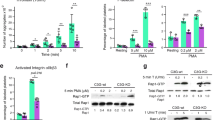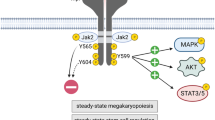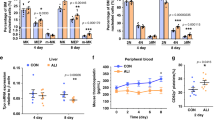Abstract
GpIbα, a subunit of the von Willebrand factor receptor, functions during blood clotting to promote platelet adhesion and activation. GpIbα is widely expressed, is positively regulated by c-Myc and is essential for the promotion of c-Myc-mediated chromosomal instability. We now show that GpIbα is also a classical oncoprotein in which its deregulated expression leads to transformation, reduced growth factor requirements, increased resistance to apoptosis, and, in primary cells, p53-dependent senescence. Finally, GpIbα also promotes double-stranded DNA breaks, and induces profound nuclear dysmorphology, indicating that, in addition to its direct transforming function, it displays genotoxicity at several distinct levels. These findings identify novel functions for GpIbα and pathways through which c-Myc mediates transformation and global genomic destabilization.
This is a preview of subscription content, access via your institution
Access options
Subscribe to this journal
Receive 50 print issues and online access
$259.00 per year
only $5.18 per issue
Buy this article
- Purchase on Springer Link
- Instant access to full article PDF
Prices may be subject to local taxes which are calculated during checkout






Similar content being viewed by others
Change history
16 February 2021
EDITOR’S NOTE: Readers are alerted that in Figure 4G, the p53-shRNA and Gplbα+p53-shRNA appear to be duplicates. As this research was performed many years ago, the authors do not have the original data. However, it does not appear that these duplications affect the overall conclusions of the article.
References
Andalis AA, Storchova Z, Styles C, Galitski T, Pellman D, Fink GR . (2004). Defects arising from whole-genome duplications in Saccharomyces cerevisiae. Genetics 167: 1109–1121.
Andreassen PR, Lohez OD, Lacroix FB, Margolis RL . (2001). Tetraploid state induces p53-dependent arrest of nontransformed mammalian cells in G1 . Mol Biol Cell 12: 1315–1328.
Andreassen PR, Lohez OD, Margolis RL . (2003). G2 and spindle assembly checkpoint adaptation, and tetraploidy arrest: implications for intrinsic and chemically induced genomic instability. Mut Res 532: 245–253.
Asazuma N, Ozaki Y, Satoh K, Yatomi Y, Handa M, Fujimura Y et al. (1997). Glycoprotein Ib-von Willebrand factor interactions activate tyrosine kinases in human platelets. Blood 90: 4789–4798.
Bartkova J, Rezaei N, Liontos M, Karakaidos P, Kletsas D, Issaeva N et al. (2006). Oncogene-induced senescence is part of the tumorigenesis barrier imposed by DNA damage checkpoints. Nature 444: 633–637.
Bild AH, Yao G, Chang JT, Wang Q, Potti A, Chasse D et al. (2006). Oncogenic pathway signatures in human cancers as a guide to targeted therapies. Nature 439: 353–357.
Brummelkamp TR, Bernards R, Agami R . (2002). A system for stable expression of short interfering RNAs in mammalian cells. Science 296: 550–553.
Canobbio I, Balduini C, Torti M . (2004). Signalling through the platelet glycoprotein Ib-V-IX complex. Cell Signal 16: 1329–1344.
Comai L . (2005). The advantages and disadvantages of being polyploid. Nat Rev Genet 6: 836–846.
Dai K, Bodnar R, Berndt MC, Du X . (2005). A critical role for 14-3-3zeta protein in regulating the VWF binding function of platelet glycoprotein Ib-IX and its therapeutic implications. Blood 106: 1975–1981.
Dang CV, O’Donnell KA, Zeller KI, Nguyen T, Osthus RC, Li F . (2006). The c-Myc target gene network. Semin Cancer Biol 16: 253–264.
Di Micco R, Fumagalli M, Cicalese A, Piccinin S, Gasparini P, Luise C et al. (2006). Oncogene-induced senescence is a DNA damage response triggered by DNA hyper-replication. Nature 444: 638–642.
Dimri GP, Lee X, Basile G, Acosta M, Scott G, Roskelley C et al. (1995). A biomarker that identifies senescent human cells in culture and in aging skin in vivo. Proc Natl Acad Sci USA 92: 9363–9367.
Ekwall K, Cranston G, Allshire RC . (1999). Fission yeast mutants that alleviate transcriptional silencing in centromeric flanking repeats and disrupt chromosome segregation. Genetics 153: 1153–1169.
Feng S, Christodoulides N, Kroll MH . (1999). The glycoprotein Ib/IX complex regulates cell proliferation. Blood 93: 4256–4263.
Fujiwara T, Bandi M, Nitta M, Ivanova EV, Bronson RT, Pellman D . (2005). Cytokinesis failure generating tetraploids promotes tumorigenesis in p53-null cells. Nature 437: 1043–1047.
Goshima G, Wollman R, Goodwin SS, Zhang N, Scholey JM, Vale RD et al. (2007). Genes required for mitotic spindle assembly in Drosophila S2 cells. Science 316: 417–421.
Grandori C, Cowley SM, James LP, Eisenman RN . (2000). The Myc/Max/Mad network and the transcriptional control of cell behavior. Annu Rev Cell Dev Biol 16: 653–699.
Harley CB, Villeponteau B . (1995). Telomeres and telomerase in aging and cancer. Curr Opin Genet Dev 5: 249–255.
Iarmarcovai G, Botta A, Orsiere T . (2006). Number of centromeric signals in micronuclei and mechanisms of aneuploidy. Toxicol Lett 166: 1–10.
Kanaji T, Russell S, Cunningham J, Izuhara K, Fox JE, Ware J . (2004). Megakaryocyte proliferation and ploidy regulated by the cytoplasmic tail of glycoprotein Ibalpha. Blood 104: 3161–3168.
Kops GJ, Weaver BA, Cleveland DW . (2005). On the road to cancer: aneuploidy and the mitotic checkpoint. Nat Rev Cancer 5: 773–785.
Korkola JE, Houldsworth J, Chadalavada RS, Olshen AB, Dobrzynski D, Reuter VE et al. (2006). Down-regulation of stem cell genes, including those in a 200-kb gene cluster at 12p13.31, is associated with in vivo differentiation of human male germ cell tumors. Cancer Res 66: 820–827.
Li Q, Dang CV . (1999). c-Myc overexpression uncouples DNA replication from mitosis. Mol Cell Biol 19: 5339–5351.
Li Y, Lu J, Prochownik EV . (2007). c-Myc-mediated genomic instability proceeds via a megakaryocytic endomitosis pathway involving Gp1balpha. Proc Natl Acad Sci USA 104: 3490–3495.
Lopez JA, Dong JF . (1997). Structure and function of the glycoprotein Ib-IX-V complex. Curr Opin Hematol 4: 323–329.
Maines JZ, Stevens LM, Tong X, Stein D . (2004). Drosophila dMyc is required for ovary cell growth and endoreplication. Development 131: 775–786.
Meek DW . (2000). The role of p53 in the response to mitotic spindle damage. Pathol Biol 48: 246–254.
Menssen A, Epanchintsev A, Rezaei N, Lodygin D, Jung P, Verdoodt B et al. (2007). c-MYC delays prometaphase by direct transactivation of MAD2 and BubR1: identification of mechanisms underlying c-MYC-induced DNA damage and chromosomal instability. Cell Cycle 6: 339–352.
Neiman PE, Kimmel R, Icreverzi A, Elsaesser K, Bowers SJ, Buraside J et al. (2006). Genomic instability during Myc-induced lymphomagenesis in the bursa of Fabricius. Oncogene 25: 6325–6335.
Nesbit CE, Tersak JM, Grove LE, Drzal A, Choi H, Prochownik EV . (2000). Genetic dissection of c-myc apoptotic pathways. Oncogene 19: 3200–3212.
Ozaki Y, Asazuma N, Suzuki-Inoue K, Berndt MC . (2005). Platelet GPIb-IX-V-dependent signaling. Thromb Haemost 3: 1745–1751.
Pierce SB, Yost C, Britton JS, Loo LW, Flynn EM, Edgar BA et al. (2004). dMyc is required for larval growth and endoreplication in Drosophila. Development 131: 2317–2327.
Prochownik EV, Li Y . (2007). The ever expanding role for C-Myc in promoting genomic instability. Cell Cycle 6: 1024–1029.
Radich JP, Dai H, Mao M, Oehler V, Schelter J, Druker B et al. (2006). Gene expression changes associated with progression and response in chronic myeloid leukemia. Proc Natl Acad Sci USA 103: 2794–2799.
Ravid K, Lu J, Zimmet JM, Jones MR . (2002). Roads to polyploidy: the megakaryocyte example. J Cell Physio 190: 7–20.
Rhodes DR, Yu J, Shanker K, Deshpande N, Varambally R, Ghosh D et al. (2004). Large-scale meta-analysis of cancer microarray data identifies common transcriptional profiles of neoplastic transformation and progression. Proc Natl Acad Sci USA 101: 9309–9314.
Rogulski K, Li Y, Rothermund K, Pu L, Watkins S, Yi F et al. (2005a). Onzin, a c-Myc-repressed target, promotes survival and transformation by modulating the Akt-Mdm2-p53 pathway. Oncogene 24: 7524–7541.
Rogulski KR, Cohen DE, Corcoran DL, Benos PV, Prochownik EV . (2005b). Deregulation of common genes by c-Myc and its direct target, MT-MC1. Proc Natl Acad Sci USA 102: 18968–18973.
Rothermund K, Rogulski K, Fernandes E, Whiting A, Sedivy J, Pu L et al. (2005). C-Myc-independent restoration of multiple phenotypes by two C-Myc target genes with overlapping functions. Cancer Res 65: 2097–2107.
Saunders W . (2003). Bridging mitotic defects and clinical diagnoses. Cancer Biol Ther 2: 253–255.
Saunders WS, Shuster M, Huang X, Gharaibeh B, Enyenihi AH, Petersen I et al. (2000). Chromosomal instability and cytoskeletal defects in oral cancer cells. Proc Natl Acad Sci USA 97: 303–308.
Sedivy JM . (2007). Telomeres limit cancer growth by inducing senescence: long-sought in vivo evidence obtained. Cancer Cell 11: 389–391.
Sedelnikova OA, Horikawa I, Zimonjic DB, Popescu NC, Bonner WM, Barrett JC . (2004). Senescing human cells and ageing mice accumulate DNA lesions with unrepairable double-strand breaks. Nat Cell Biol 6: 168–170.
Serrano M, Lin AW, McCurrach ME, Beach D, Lowe SW . (1997). Oncogenic ras provokes premature cell senescence associated with accumulation of p53 and p16INK4a. Cell 88: 593–602.
Sotillo R, Hernando E, Diaz-Rodriguez E, Teruya-Feldstein J, Cordon-Cardo C, Lowe SW et al. (2007). Mad2 overexpression promotes aneuploidy and tumorigenesis in mice. Cancer Cell 11: 9–23.
Storchova Z, Breneman A, Cande J, Dunn J, Burbank K, O’Toole E et al. (2006). Genome-wide genetic analysis of polyploidy in yeast. Nature 443: 541–547.
Thomas PD, Campbell MJ, Kejariwal A, Mi H, Karlak B, Daverman R et al. (2003). PANTHER: a library of protein families and subfamilies indexed by function. Genome Res 13: 2129–2141.
Thorpe PH, Gonzalez-Barrera S, Rothstein R . (2007). More is not always better: the genetic constraints of polypolidy. Trends Genet 23: 263–266.
Weaver BA, Cleveland DW . (2006). Does aneuploidy cause cancer? Curr Opin Cell Biol 18: 658–667.
Weinstock DM, Richardson CA, Elliott B, Jasin M . (2006). Modeling oncogenic translocations: distinct roles for double-strand break repair pathways in translocation formation in mammalian cells. DNA Repair 5: 1065–1074.
Yin XY, Grove L, Datta NS, Long MW, Prochownik EV . (1999). C-myc overexpression and p53 loss cooperate to promote genomic instability. Oncogene 18: 1177–1184.
Yin X, Grove L, Rogulski K, Prochownik EV . (2002). Myc target in myeloid cells-1, a novel c-Myc target, recapitulates multiple c-Myc phenotypes. J Biol Chem 277: 19998–20010.
Zhou ZQ, Hurlin PJ . (2001). The interplay between Mad and Myc in proliferation and differentiation. Trends Cell Biol 11: S10–S14.
Acknowledgements
We thank Reuven Agami for pSUPER-shp53 vector and Bill Saunders for valuable discussions. This work was supported by NIH grants RO1CA078259 and RO1 CA105033 to EVP and by a Children's Hospital of Pittsburgh Research Advisory Committee postdoctoral fellowship award to YL.
Author information
Authors and Affiliations
Corresponding author
Additional information
Supplementary Information accompanies the paper on the Oncogene website (http://www.nature.com/onc).
Rights and permissions
About this article
Cite this article
Li, Y., Lu, J., Cohen, D. et al. Transformation, genomic instability and senescence mediated by platelet/megakaryocyte glycoprotein Ibα. Oncogene 27, 1599–1609 (2008). https://doi.org/10.1038/sj.onc.1210794
Received:
Revised:
Accepted:
Published:
Issue Date:
DOI: https://doi.org/10.1038/sj.onc.1210794
Keywords
This article is cited by
-
The deubiquitinase USP21 stabilizes MEK2 to promote tumor growth
Cell Death & Disease (2018)



